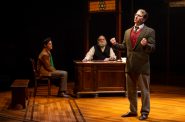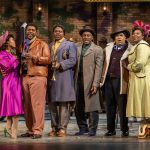Blues, sex, talent, intensity at the Rep’s Stackner Cabaret
The Rep's "Blues in the Night" honors the Blues and the bluesy, from Bessie Smith to Johnny Mercer and beyond.

Carl Clemons-Hopkins, Dan Kazemi, Lili Thomas, Zonya Love and Halle Morse in “Blues in the Night” at the Stackner Cabaret. Michael Brosilow photo for the Milwaukee Rep.
In the Blues, a buggy ride is no buggy ride.
Love’s character meant business — she wants sex and is telling, not asking — and that made the number insanely funny. Love as a musician meant business, too, growling and belting like the hottest red-hot mama of 1933.
Love represented the red-hot mama Blues Woman, a veteran of the business and of life, bawdy in public but world-weary in private, and not worldly-wise. She showed us her tragic side in several numbers, notably a gospel-tinged reading of “Wasted Life Blues” that brought down the house. Lili Thomas played the Sophisticated Lady, the sultry torch singer of some experience; she knows the score. Halle Morse was the bright chorine, a bundle of artistic and sexual energy and about to take some of life’s hard, transforming knocks.

Zonya Love and Carl Clemons-Hopkins take a little “Buggy Ride.” If you get my meaning. Michael Brosilow photo for the Milwaukee Rep.
Together, they cover the three Blues female archetypes; the show hints that they might be three phases of the same woman. Director Megan Nicole O’Brien and scenic designer Megan Truscott put them in the same dingy one-room apartment, when they’re not on the little bandstand at stage right. Lighting designer Craig Gottschalk magically isolates or combines them as needed, in addition to subtly highlighting the shifting moods of the music and the women. Clemons-Hopkins, a strapping fellow with a rich bass-baritone, an irresistible smile and winning casual ways, is the Blues Everyman, a lovable Sportin’ Life. He’s fun while he lasts and loses no sleep over a woman’s tears.
Sheldon Epps, who created the show in 1980, didn’t have to invent any of these characters. They have existed for over a century, in the lyrics of blues songs as they emerged from coon songs and evolved further into Tin Pan Alley and jazz. The range extends to boogie-woogie as it blends with blues and country to form early rock ‘n’ roll. The singing actors understood the enduring sentiments and the changing musical idioms. They plunged into the songs and characters and brought both to full stature, in all their dignity, carnality, recklessness, joy, anger and regret.
The music expressed all of that, in fine shadings that grew as much from knowing, inventive interpretation as from the lyrics and notes. All these singers, but especially Thomas and Love, demonstrated that these are no mere fossils from an antique pop culture. These songs run deep into human nature if you sing them right.
Thomas cast a gripping tragic spell with Billy Strayhorn’s Lush Life, as profound an essay on the withering of the soul as exists in our culture. She brought up the volume just a little but tightened the intensity to a white heat in her vocal timbre and body language. On the sultry, kittenish side, Thomas loosened our ties with a remarkably slow and seductive take on “Stompin’ at the Savoy” and, in black lace (great costumes by Holly Payne) in Act 2, with an aggressively flirty “Rough and Ready Man.”
“Rough and Ready Man” was the exception for Thomas, who was mostly assigned jazz-inflected tunes from the 1930s and ’40s. Love mostly covered the older, purer Blues. Morse, owner of a laser-beam soprano that contrasted with the other voices, tended toward later songs, notably Ann Ronell’s “Willow Weep for Me,” “I’ve Got a Date with a Dream” and a delightful “Taking a Chance on Love.”
The arrangements, originally by Chapman Roberts with amendments and additions by Sy Johnson, are fabulous. Transitional overlaps among soloists often tie the songs together ingeniously. The three women and sometimes all four singers come together in glorious harmony, notably in Harold Arlen and Johnny Mercer’s “Blues in the Night.” The three women blasted “Take It Right Back” at Clemons-Hopkins and, again, it was funny and ferocious all at once. They meant it when they sang, “Take it back to the place that you got it, I’m gonna pick up the broom and sweep it outta here.”
This solid show would be fine with decent singing actors and competent accompanists on piano and drums. At the Rep, Blues in the Night benefits from a cast and musicians with extraordinary skills that expand the dimensions of the show. Music director Dan Kazemi doubles on piano, clarinet and banjo-uke. Drummer Patrick Morrow jumps up to play guitar and bass. Clemons-Hopkins played bass through most of the show and harmonica occasionally. Morris played real, scored percussion on the apartment’s furniture. Thomas played trumpet and I don’t mean a note here and there – she played throughout the show and dropped in a few impressive extended solos. She also played piano, guitar, banjo-uke and euphonium.
The great individual talent and charisma meshed in a group effort that became more and more exciting and moving as it went on. They made every number count, and those numbers accumulated meaning and momentum. At the end, the audience could do nothing but explode into an ovation as intense and heartfelt as the show it had just witnessed.
Blues in the Night runs through Dec. 23. For tickets and further information, visit the Rep’s website or call the box office, 414 224-9490.
Theater
-
‘L’Appartement’ Is a Mind-Bending Comedy
 Mar 25th, 2024 by Dominique Paul Noth
Mar 25th, 2024 by Dominique Paul Noth
-
‘The Mountaintop’ Offers Very Human Martin Luther King Jr.
 Mar 11th, 2024 by Dominique Paul Noth
Mar 11th, 2024 by Dominique Paul Noth
-
‘The Chosen’ Is Subtly Powerful Drama
 Mar 10th, 2024 by Dominique Paul Noth
Mar 10th, 2024 by Dominique Paul Noth



















Sounds like a fabulous show. It actually runs through Dec 23, though, not Oct 23, so there’s still plenty of time to grab up some seats.
See this show! It is great.
Thanks, Janet. Date fixed. — Strini